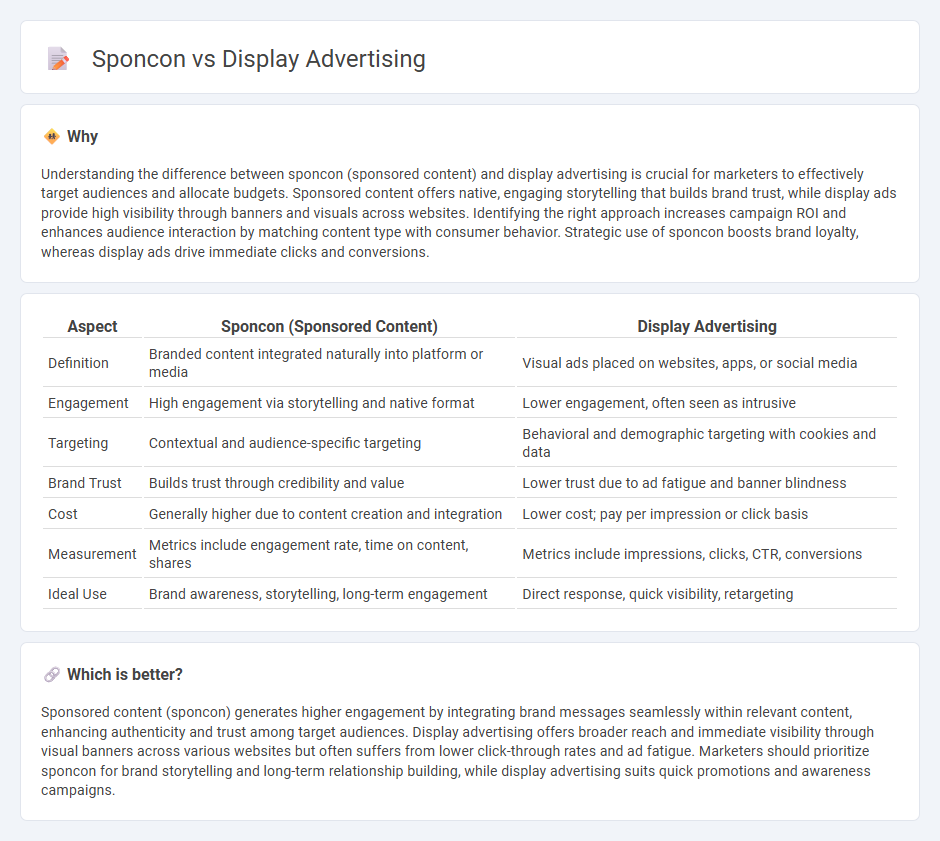
Sponsored content seamlessly integrates brand messages within editorial environments, enhancing audience engagement through native storytelling and trust. Display advertising relies on visual banners strategically placed across websites to drive immediate brand recognition and direct clicks. Explore the differences and benefits of these powerful marketing strategies to elevate your campaign success.
Why it is important
Understanding the difference between sponcon (sponsored content) and display advertising is crucial for marketers to effectively target audiences and allocate budgets. Sponsored content offers native, engaging storytelling that builds brand trust, while display ads provide high visibility through banners and visuals across websites. Identifying the right approach increases campaign ROI and enhances audience interaction by matching content type with consumer behavior. Strategic use of sponcon boosts brand loyalty, whereas display ads drive immediate clicks and conversions.
Comparison Table
| Aspect | Sponcon (Sponsored Content) | Display Advertising |
|---|---|---|
| Definition | Branded content integrated naturally into platform or media | Visual ads placed on websites, apps, or social media |
| Engagement | High engagement via storytelling and native format | Lower engagement, often seen as intrusive |
| Targeting | Contextual and audience-specific targeting | Behavioral and demographic targeting with cookies and data |
| Brand Trust | Builds trust through credibility and value | Lower trust due to ad fatigue and banner blindness |
| Cost | Generally higher due to content creation and integration | Lower cost; pay per impression or click basis |
| Measurement | Metrics include engagement rate, time on content, shares | Metrics include impressions, clicks, CTR, conversions |
| Ideal Use | Brand awareness, storytelling, long-term engagement | Direct response, quick visibility, retargeting |
Which is better?
Sponsored content (sponcon) generates higher engagement by integrating brand messages seamlessly within relevant content, enhancing authenticity and trust among target audiences. Display advertising offers broader reach and immediate visibility through visual banners across various websites but often suffers from lower click-through rates and ad fatigue. Marketers should prioritize sponcon for brand storytelling and long-term relationship building, while display advertising suits quick promotions and awareness campaigns.
Connection
Sponsored content (sponcon) and display advertising both serve as digital marketing strategies designed to increase brand visibility and engagement through targeted placements. Sponcon integrates promotional messages seamlessly within editorial content, enhancing authenticity and user trust, while display advertising leverages visually compelling banners or videos on websites to capture audience attention instantly. Combining sponcon with display advertising maximizes reach and reinforces brand messaging across multiple touchpoints, driving higher conversion rates and customer retention.
Key Terms
Banner Ads
Banner ads, a key element of display advertising, use visually engaging graphics to capture user attention across websites, driving brand visibility and direct response. Sponsored content blends seamlessly into editorial environments, enhancing trust and engagement by providing valuable, relevant information alongside promotional elements. Explore how these strategies differ in impact and application to optimize your advertising performance.
Native Content
Native content blends seamlessly with platform design, enhancing user engagement by providing relevant, non-disruptive advertising experiences. Display advertising relies on visually striking banners or videos that often interrupt user activities but offer broad reach and immediate visibility. Explore how native content and display ads can be strategically utilized to maximize brand awareness and user interaction.
Audience Targeting
Display advertising leverages detailed demographic, geographic, and behavioral data to precisely target audiences across websites, maximizing reach through real-time bidding and programmatic platforms. Sponsored content (sponcon) targets engaged users by integrating brand messages within content that aligns with audience interests, enhancing trust and relevance through native placement. Explore how combining display ads and sponsored content can optimize audience targeting strategies effectively.
Source and External Links
What Is Display Advertising? Types of Display Ads Explained - Display advertising is a type of digital marketing that places visual ads--such as banner images or videos--on websites, apps, or other digital platforms, often targeted based on user behavior and demographics and frequently served through networks like Google Display Network which use responsive ads adaptable to various devices.
The complete guide to display advertising - Display ads combine elements like banners, text, images, and video to increase brand reach, target specific audiences using geotargeting, and achieve objectives like brand awareness, lead generation, or web traffic, often providing cost-effective, trackable, and customizable campaign options.
What is Display Advertising? A Beginner's Guide - Display advertising uses online ads combining copy, visuals, and calls to action linking to landing pages, typically appearing alongside website content, serving to broaden brand reach and deliver measurable results within integrated marketing strategies across diverse digital platforms.
 dowidth.com
dowidth.com